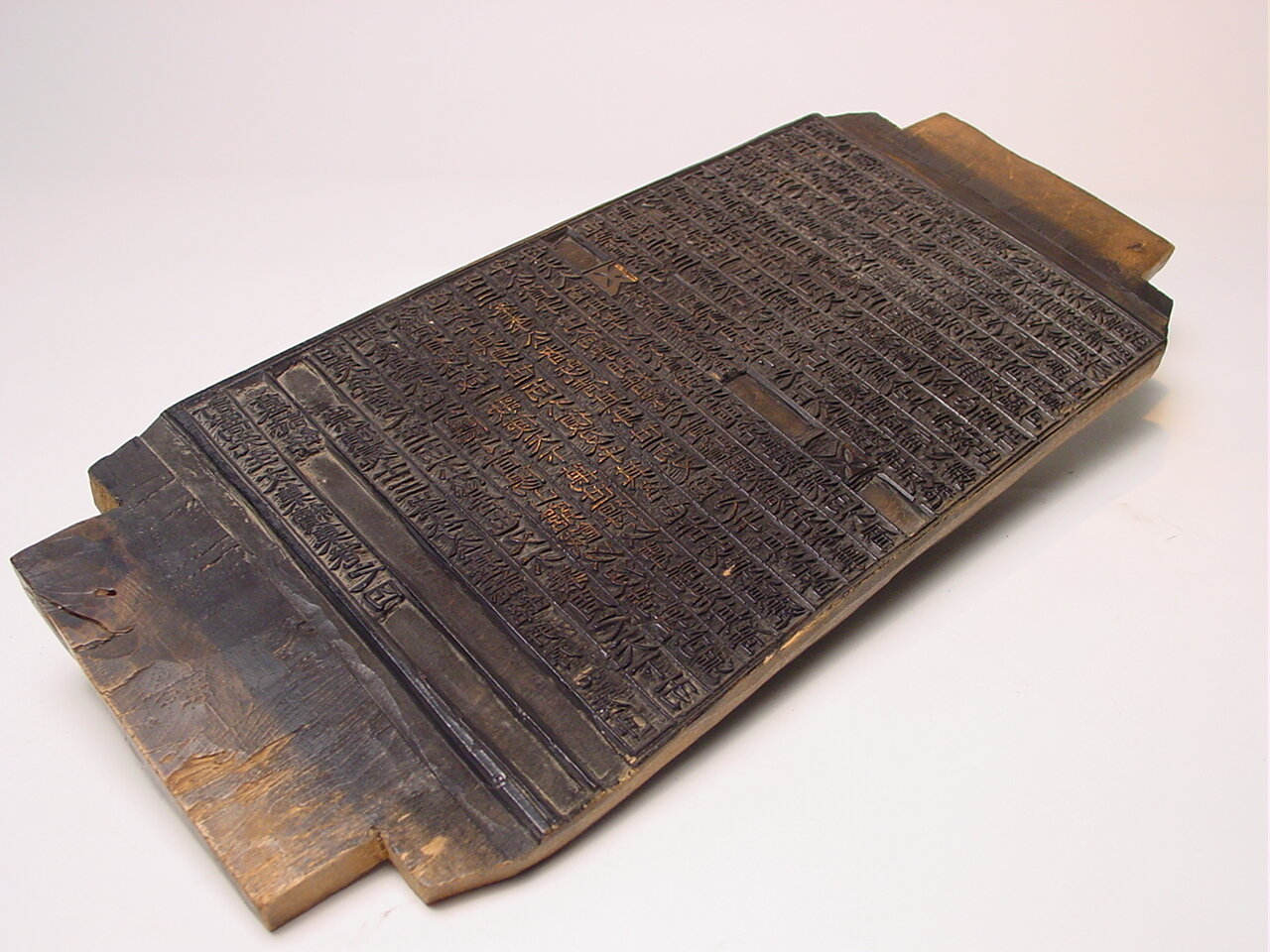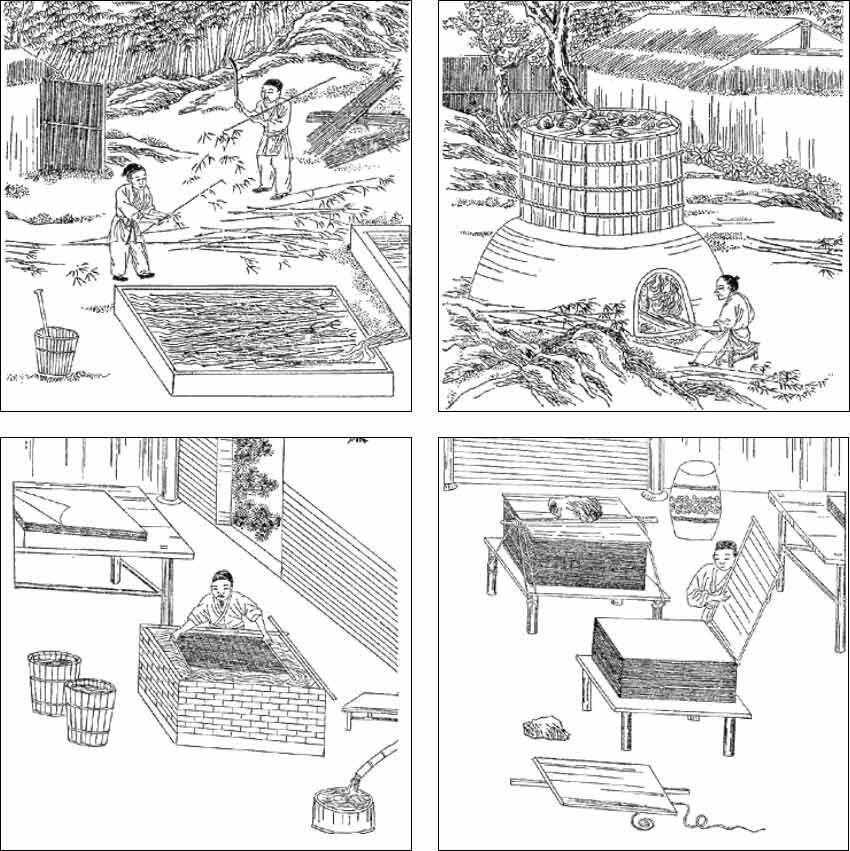THE HISTORY OF THE BOOK IN ASIA Part I
/Part One: China and Japan
If you were to ask someone “who invented printing?” there is a good chance they would answer, “Gutenberg, of course!” Although Gutenberg was the first person in Europe to invent the printing press and moveable metal type, printing predated him by several centuries. In fact, printing wasn’t invented in Europe at all– it started in Asia.
For Asian American Heritage month, we will be exploring the history of the book in Asia. We will dive into how paper making, bookbinding, and printing varied between different regions and cultures. We’re starting in East Asia, with the country that first invented printing and paper: China!
The invention of paper is attributed to an imperial official from the Han Dynasty named Ts’ai Lun, who purportedly came up with the idea in 105 A.D. In reality, the idea may have predated Ts’ai Lun, but his close relationship to the imperial court meant his name went down in history. Before paper, Chinese scribes would use pieces of bamboo or wood to write on, then later they began to use silk and cloth. All of these materials were difficult to write on and silk was too expensive for it to find widespread use. Paper was a huge improvement and proved to be a revolutionary invention. Chinese papermakers made pulp from readily available waste products, like rags and fishnets, as well as fresh plant fibers like bamboo and mulberry bark (called Kozo).
The invention of paper led to a significant increase in books and literacy across China, but printing moved things a step further. Printing took a number of different forms in China. The oldest of these forms was woodblock printing, which began about 500 years after Ts’ai Lun’s lifetime. With this method, an entire page of text would be carved onto a block of wood, coated in ink, and pressed onto a sheet of paper. Around 1040 A.D., a Chinese artisan named Bi Sheng came up with the idea of using moveable wooden type that could be repurposed for many books, instead of carving one page at a time. Later inventors replicated this idea but instead used clay to shape their characters. A man named Wang Zhen is credited with improving on these forms of moveable type and creating a distinctive circular type case that spun so you could easily access different characters. However, these clay and wood characters had a number of imperfections that kept them from taking off in China to the same extent that moveable metal type spread in Europe. Additionally, the Chinese alphabet contains thousands of characters, much more than European alphabets. It was very time consuming to carve all of them and to sort through them when typesetting. So, despite the invention of moveable type, wood blocks remained the most popular form of printing in China.
Before paper became widely available, Chinese texts were written on silk scrolls. However, scrolls were inconvenient in many ways– silk was expensive, delicate, and difficult to write on, plus the scrolls were cumbersome to store and time consuming to unroll. The invention of paper and printing marked a shift away from this. Written texts in China began to look more like our conventional idea of a book. Accordion books began to appear in China around the fifth century as more efficient alternatives to scrolls. These books were made of folded strips of paper that were tucked inside a paper cover.
China was at the forefront of printing, paper making, and bookbinding long before Gutenberg was born. A Buddhist text called the Diamond Sutra, which was made using all the methods described here, in 868 A.D. during the Tang Dynasty, is believed to be the oldest printed book in the world. China used their technological advances to spread literacy while only a privileged few had access to handwritten manuscripts in the West.
Now we’re shifting our focus from China to the neighboring country of Japan. We will explore how Japan used existing ideas in China to come up with their own methods of book production.
Since China and Japan are neighbors, Japanese artisans adopted quite a few ideas from the Chinese when it came to producing books. They borrowed their methods of papermaking and woodblock printing. Like the Chinese, the Japanese also used silk scrolls to write down important texts and then began to make accordion style books once they had access to paper.
The Chinese method of making paper was introduced to Japan in the 7th century by the Korean Buddhist monk, Doncho. Japanese papermakers thought Chinese paper was too delicate, so they modified the process to make their own paper stronger and more flexible. Japanese paper is called Washi and it is made using a very traditional process. Papermakers were typically farmers, first and foremost. They would grow plants for paper alongside their other crops and use the fibers to create pulp. These fibers included hemp, tree bark (specifically kozo, gampi, and mitsumata), and a substance called neri, that was added to pulp to help papermakers pull more even sheets. Making washi was a seasonal activity that took place in rural areas. In the winter, when it was too cold for farmers to work in their fields, they would pull sheets of paper using icy water to ensure their washi was free of impurities.
Between the 12th to 14th century, Japan began to come up with their own styles of bookbinding. The oldest book structure they used was a multi-section binding that looked very similar to the sewn signatures in Western style books. The most recognizable book form was a four-hole binding that many binders nowadays refer to as a Japanese stab stitch. Bookbinders would fold their pages in half, text side out, and sew through holes the paper cover to join the pages together. Folding pages in half so they were blank on the inside was a practical choice. The ink that was used for printing and calligraphy bled through thin washi paper, so it made sense to create book pages with a double leaf.
Printed books had a limited scope in Japan until the 1600s. There were printed Buddhist texts for religious purposes and calligraphic manuscripts for the elite, but the processes for producing these books were so labor intensive and expensive that printed books did not spread very quickly. This changed during the Edo Period, when the stability of shogunate leadership led to an increase in paper production. During this time, books were printed on every subject imaginable and literacy began to spread. The biggest change came in the 1800s when Western technology was introduced to Japan, kickstarting an industrial revolution. Printing presses, thick machine-made paper, and metal type begin to permeate the field of book production.
Although industrialization changed the field of printing, bookbinding, and papermaking in Japan, it did not erase any of the country’s traditional practices. Japanese woodblock printing and bookbinding are still art forms that are practiced today. The craft of producing traditional washi is even registered as a form of intangible cultural heritage under UNESCO.









